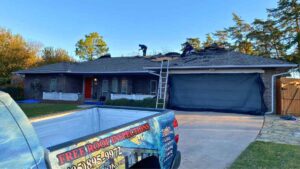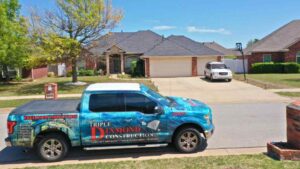When choosing a roof for your home, especially if you live in an area prone to severe weather like Oklahoma, the type of roofing material you select can have a significant impact on how well your roof withstands hail. Having a roof that can withstand large hail can help save money on insurance premiums, deductibles, and repairs after yearly storms.
But what type of roofing material offers the best resistance to hail damage?
In this blog, we’ll explore the most common roofing materials—such as asphalt shingles, metal, tile, and more—and compare their resistance to hail damage. We’ll also discuss the factors you should consider when selecting the best roofing material for your home, balancing durability, cost, and overall performance.
1. Asphalt Shingles
Resistance to Hail Damage: Moderate
Asphalt shingles are one of the most popular roofing materials in the U.S. due to their affordability and ease of installation. However, when it comes to resistance to hail damage, not all asphalt shingles are created equal.
Standard three-tab asphalt shingles are generally rated to withstand hail up to 1.25 inches in diameter, but larger hailstones can easily cause granule loss, bruising, and cracking. This type of damage can reduce the shingles’ effectiveness in protecting your home from water intrusion and UV exposure. However, newer impact-resistant shingles are designed to better withstand hail, featuring reinforced materials that can absorb impact without cracking.
Cost:
- Standard Asphalt Shingles: $100–$150 per square (100 sq. ft.)
- Impact-Resistant Shingles: $200–$300 per square
Durability:
- Lifespan: 15–30 years, depending on the quality of the shingle and weather exposure
- Maintenance: Requires yearly roof inspections, especially after hailstorms, to check for granule loss and cracking
Asphalt Shingles Are Best For:
Homeowners on a budget who want an affordable roofing option, but upgrading to impact-resistant shingles is recommended for areas prone to frequent hailstorms.
2. Metal Roofing
Resistance to Hail: High
Metal roofing is one of the most durable options available for homeowners, and its ability to resist hail damage is one of its standout features. Made from materials like steel, aluminum, or copper, metal roofs are typically strong enough to withstand large hailstones without puncturing or cracking. While large hail may dent a metal roof, it’s unlikely to cause functional damage unless the dents are severe.
One of the benefits of metal roofing is that it can last for 40–70 years with minimal maintenance. Additionally, metal roofs are fire-resistant, eco-friendly, and highly energy-efficient, reflecting sunlight to reduce cooling costs in warmer months.
Cost:
- Steel or Aluminum: $300–$600 per square
- Copper: $800–$1,500 per square
Durability:
- Lifespan: 40–70 years
- Maintenance: Minimal maintenance is required; however, dents from hail may need to be repaired if they affect the roof’s appearance or function
Metal Roofs Are Best For:
Homeowners that are looking for a long-lasting, hail-resistant roofing option with higher upfront costs but lower maintenance over time.
3. Clay and Concrete Tile Roofing
Resistance to Hail: Moderate to High
Tile roofing, whether clay or concrete, is another durable option, particularly in areas prone to high winds and hail. Clay and concrete tiles are thick and heavy, which allows them to absorb the impact of hailstones more effectively than lighter materials like asphalt shingles.
That said, while tile roofs are resistant to small- and medium-sized hail, they are not immune to damage. Large hailstones can crack or break tiles, and the cost of replacing damaged tiles can add up. Still, tile roofs are valued for their long lifespan, energy efficiency, and ability to withstand a variety of weather conditions.
Cost:
- Clay Tile: $700–$1,000 per square
- Concrete Tile: $400–$600 per square
Durability:
- Lifespan: 50–100 years
- Maintenance: Requires professional replacement of cracked or broken tiles
Clay Or Tile Roofing Is Best For:
Homeowners in warm climates who are looking for a durable, energy-efficient roof that can handle moderate hail but may need repairs after larger storms.
4. Wood Shakes and Shingles
Resistance to Hail: Moderate to Low
Wood shakes and shingles offer a natural and rustic look but are less resistant to hail damage compared to other materials. Hailstones can split or dent wood shingles, leading to increased maintenance and higher costs over time. Additionally, wood is prone to water damage and mold growth if it’s not properly sealed or maintained, particularly after hail damage has exposed the surface.
Cost:
- Wood Shakes/Shingles: $400–$700 per square
Durability:
- Lifespan: 20–40 years, depending on maintenance and climate
- Maintenance: High maintenance is required, including sealing, cleaning, and replacing split or damaged shingles
Wood Shake Roofs Are Best For:
Homeowners who prioritize aesthetic appeal over durability in hail-prone areas should consider other roofing options.
5. Slate Roofing
Resistance to Hail: High
Slate roofing is one of the most durable materials on the market, with excellent resistance to both hail and fire. Slate is a dense, natural stone that can withstand even large hailstones without cracking. It also boasts an extremely long lifespan, often lasting over 100 years with proper maintenance.
However, slate roofing is expensive and requires specialized installation, making it less common for average homeowners. It is also very heavy, which means your home may require additional structural support to accommodate a slate roof.
Cost:
- Slate Roofing: $1,000–$2,000 per square
Durability:
- Lifespan: 75–150 years
- Maintenance: Low maintenance, though professional inspections are recommended after major storms
Slate Roofing Is Best For:
Homeowners looking for a high-end, hail-resistant roofing material that offers superior durability and longevity, with the trade-off of higher upfront costs.
How to Choose the Best Roofing Material for Hail Resistance
When deciding which roofing material is best for your home, especially in hail-prone areas like Oklahoma, here are some factors to consider:
- Durability and Hail Resistance: Metal, slate, and impact-resistant asphalt shingles offer the best hail resistance, withstanding larger hailstones without significant damage.
- Cost: Asphalt shingles are the most affordable option, but investing in impact-resistant versions can save you money on future repairs. Metal and slate are more expensive but provide long-term durability and lower maintenance costs.
- Aesthetic Preferences: Consider how each material complements the style of your home. For instance, tile and slate roofs offer a traditional look, while metal roofing has a more modern, sleek appearance.
- Climate Considerations: While hail resistance is important, you’ll also want to consider other factors like wind, snow, and heat when selecting a roofing material.
Key Takeaways On Roofing Materials Resistance To Hail Damage
Choosing the right roofing material is an important decision that affects not only your home’s appearance but also its durability and performance during hailstorms. If you’re in the market for a roof replacement or just want to assess your current roof’s hail resistance, contact Triple Diamond Construction for a free consultation and inspection.
Call us at 405-895-9972 or visit https://triplediamondok.com/free-roof-inspection-okc/ to schedule a roof inspection online now!
By selecting the right material, you can ensure your home is protected from future hailstorms, saving you money on repairs and extending the lifespan of your roof.





